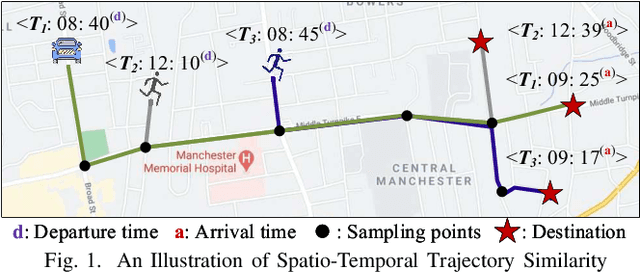ST2Vec: Spatio-Temporal Trajectory Similarity Learning in Road Networks
Paper and Code
Dec 17, 2021



People and vehicle trajectories embody important information of transportation infrastructures, and trajectory similarity computation is functionality in many real-world applications involving trajectory data analysis. Recently, deep-learning based trajectory similarity techniques hold the potential to offer improved efficiency and adaptability over traditional similarity techniques. Nevertheless, the existing trajectory similarity learning proposals emphasize spatial similarity over temporal similarity, making them suboptimal for time-aware analyses. To this end, we propose ST2Vec, a trajectory-representation-learning based architecture that considers fine-grained spatial and temporal correlations between pairs of trajectories for spatio-temporal similarity learning in road networks. To the best of our knowledge, this is the first deep-learning proposal for spatio-temporal trajectory similarity analytics. Specifically, ST2Vec encompasses three phases: (i) training data preparation that selects representative training samples; (ii) spatial and temporal modeling that encode spatial and temporal characteristics of trajectories, where a generic temporal modeling module (TMM) is designed; and (iii) spatio-temporal co-attention fusion (STCF), where a unified fusion (UF) approach is developed to help generating unified spatio-temporal trajectory embeddings that capture the spatio-temporal similarity relations between trajectories. Further, inspired by curriculum concept, ST2Vec employs the curriculum learning for model optimization to improve both convergence and effectiveness. An experimental study offers evidence that ST2Vec outperforms all state-of-the-art competitors substantially in terms of effectiveness, efficiency, and scalability, while showing low parameter sensitivity and good model robustness.
 Add to Chrome
Add to Chrome Add to Firefox
Add to Firefox Add to Edge
Add to Edge